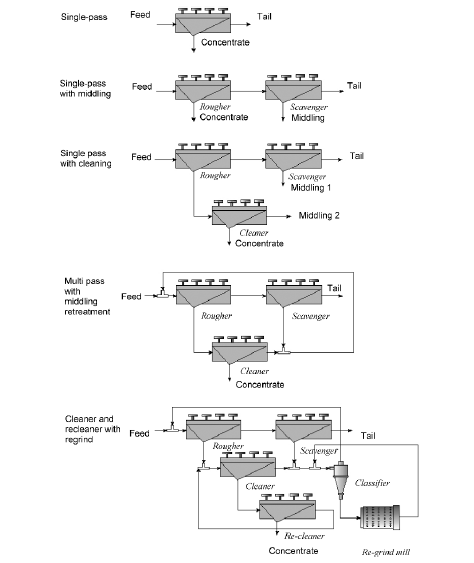In mineral processing plant such as iron ore processing line, gold ore processing and nonmetallic ore processing ,the flotation process is usually adopted. Flotation is carried out as a continuous operation in a series or bank of cells. This increases the floating time, allowing ample opportunity for particle-bubble attachment to occur. The residence time of particles in the bank of flotation cells range from 5 to 15 minutes. The rate at which the particles float will depend on particle composition, pulp density, particle size and degree of turbulence in the cell. The arrangement of a number of cells in series allows the collection of different products from the various cells. For example, liberated particles in general float more rapidly than composite particles so that a high grade concentrate can be collected from the first few cells in a bank and froth from the remaining cells can be collected as a middling concentrate.

Quite often the grade of concentrate recovered from a single stage of flotation is not high enough and requires re-floating in one or more stages of flotation referred to as cleaner or recleaner stages. The series of cells that produce the initial concentrate is called the rougher stage and any subsequent retreatment of the rougher tailings is referred to as scavenging. The scavenger section of the flotation circuit is given higher reagent dosages and long flotation time to float as much valuable mineral as possible and maximise recovery. On the other hand the cleaner stage experiences milder flotation conditions of lower pulp density and lower reagent concentrations to reduce entrainment in the froth and to ensure only the high grade particles will float. To maximise the grade from the cleaner cells, the residence times is generally shorter. For example, rougher and scavenger flotation might take 10 minutes and cleaner flotation, 3 minutes.
The concentrate product from the scavenger cells and/or the tailings from the cleaner or recleaner cells are usually low grade because of locked or composite particles and physically entrained gangue minerals. Also it may contain free valuable mineral particles, present due to physical entrainment, odd shape or size or surface contamination. These low grade products maybe retreated by a re-grind stage and further flotation. The details of the regrinding practice depend largely on the ore characteristics. For example the presence of composites in any concentrate (such as the rougher concentrate) in any great number would dictate that the concentrate be sent for re-grinding.
The machines are important in gold ore mineral processing like flotation machine and other gold mining equipment, and the flotation circuit is also important, An example of some flotation circuits arrangements are shown in Fig. 1. A flotation circuit usually contains some provision for handling fluctuations in the flowrate of ore to the plant, either minor or major. Any minor fluctuations can be smoothed out by incorporating an agitator/conditioning tank between the grinding section and the flotation circuit. This is used to maintain a constant rate of feed to the flotation cells and to condition the feed with initial reagent prior to entering the cell. In addition, recovery is often improved by some degree of staged addition of reagents down the bank of cells. In some cases, additional conditioning time is provided by adding reagents to the grinding mill feed and/or discharge.
To accommodate large fluctuations of flow rate, for example if part of the grinding circuit is shut down for maintenance, the flotation circuit can be run in a number of identical modules operating in parallel. If the flow rate drops dramatically then this can be handled by shutting down one or more banks of cells. The more parallel modules built in, the more flexible the plant, but the greater are the control problems involved.
The number and size of cells required in a plant is determined by a number of factors, primarily the tonnage flow rate of material through the circuit. A large number of small cells gives greater flexibility and metallurgical performance whereas a small number of large cells of the same total capacity have a smaller capital cost, less floor area per unit volume and lower power consumption and lower operating costs. With the higher tonnages of lower grade ore now being treated by the minerals industry, the trend is towards large volume flotation cells. The choice of flotation cell size best suited to any specific application must consider the pulp flow rate, the number of parallel modules in the flotation section, the minimum number of cells in each row required to eliminate pulp short-circuiting and the required pulp residence time.